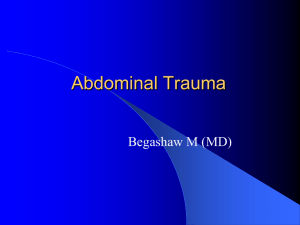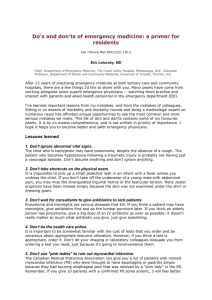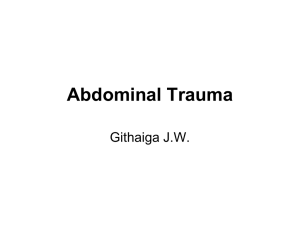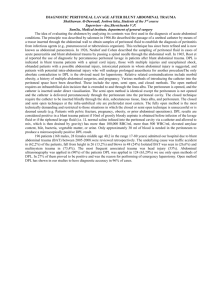Powerpoint File
advertisement
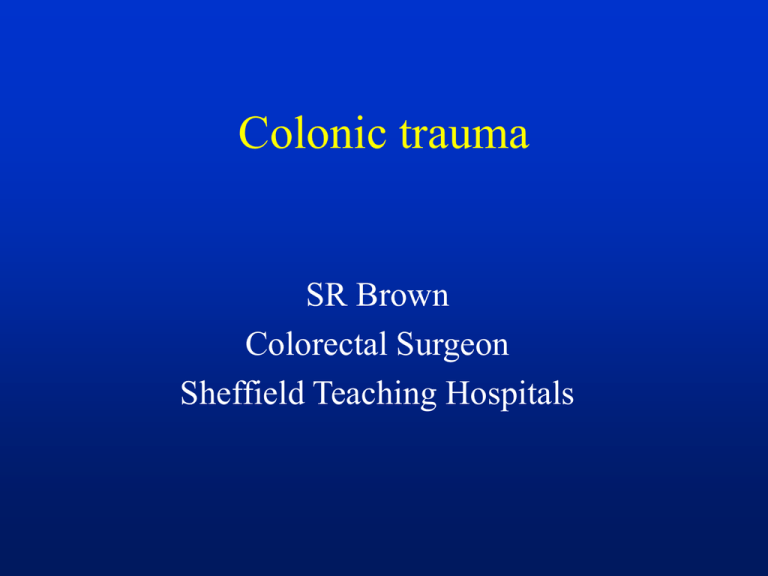
Colonic trauma SR Brown Colorectal Surgeon Sheffield Teaching Hospitals Types of trauma • Penetrating trauma – Gunshots • Energy transfer proportional to velocity • Cavitation – Injury away from track – Contamination sucked in – Stab wounds • Low level energy transfer • Injury confined to track Blunt trauma • Mechanisms for damage – – – – Crushing Shearing Bursting Penetrating Evaluation of abdominal penetrating trauma • Haemodynamically unstable – Laparotomy • Haemodynamically stable – – – – – – – Serial clinical exam Local wound exploration DPL FAST CT Laparoscopy Laparotomy DPL • Positive if – – – – – >10ml frank blood RCC>100,000/mm3 WCC>500/mm3 Amylase>20 IU/L Presence bacteria/bowel contents Adjuncts to evaluation • • • • CXR NG tube Catheter PR Pros/cons • • • • • • Awake/cooperative patient Invasive Admission Retroperitoneum High clinical workload Complications CT features of penetrating abdominal injury • Signs of peritoneal violation – Free air/fluid – Track • Signs of bowel injury – Thickening/defect – Contrast leak • Others – Intravenous contrast leak – Diaphragm tear Evaluation of blunt abdominal trauma • Haemodynamically unstable – DPL/FAST/CT • Haemodynamically stable – Serial examination – FAST – CT Surgery for abdominal trauma Advantages of primary repair • Reduced morbidity of colostomy closure • Reduced disability of colostomy • Reduced hospital stay Colonic surgery; primary repair Primary repair Colostomy Leak Stone, 1979 69 72 1 Chappuis, 1991 28 28 0 Falcone, 1992 12 12 0 Sasaki, 1995 43 28 0 Gonzalez, 1996 56 53 2 Total 208 193 3 Colonic injury; primary repair in destructive injury Primary repair Colostomy Leak Chappuis, 1991 11 28 0 Falcone, 1992 12 12 0 Sasaki, 1995 12 28 0 Gonzalez, 1996 5 53 1 Total 121 1 40 Risk factors for primary repair • • • • Haemodynamicaly unstable Significant underlying disease Associated injuries Peritonitis Damage control surgery • ‘Multiple trauma patients are more likely to die from intra-operative metabolic failure than a failure to complete operative repairs’ Pathophysiology • Hypothermia • Acidosis • Coagulopathy Principles of surgery • Control haemorrhage • Prevent contamination • Avoid further injury Principles of colonic surgery • Repair small enterotomies • Extensive damage resect and close off ends • No stomas – Time consuming – Spillage difficult to control Abdominal compartment syndrome • Pressure >25cm water • Oedema – – – – Reperfusion injury Crystalloid infusion Capillary leakage Packing Pathophysiology • Cardiovascular – Decrease cardiac output despite high CVP • Respiratory – Splint diaphragm • Renal – Oliguria due to renal vein/parenchyma compression • Cerebral – Increased CVP results in decreased cerebral drainage Diagnosis • Oliguria + increasing CVP • Foley catheter in bladder – Normal 0 cm water – >25cm water suggestive – >30cm water diagnostic Treatment • Anticipate – Difficulty closing – Horizontal view, guts above level of wall • Laparostomy – Bogota bag – VAC dressing
